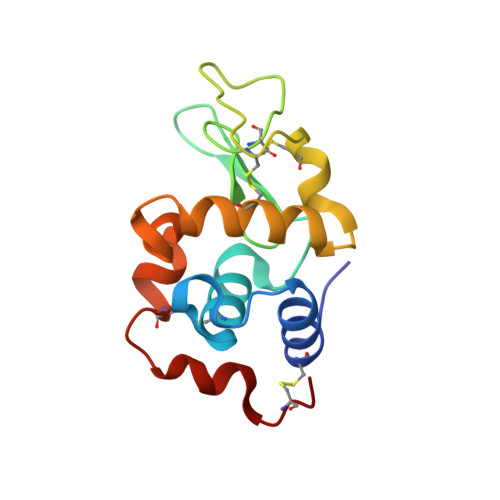Nonspecific Binding of Adenosine Tripolyphosphate and Tripolyphosphate Modulates the Phase Behavior of Lysozyme.
Zalar, M., Bye, J., Curtis, R.(2023) J Am Chem Soc 145: 929-943
- PubMed: 36608272
- DOI: https://doi.org/10.1021/jacs.2c09615
- Primary Citation of Related Structures:
8AAZ - PubMed Abstract:
Adenosine tripolyphosphate (ATP) is a small polyvalent anion that has recently been shown to interact with proteins and have a major impact on assembly processes involved in biomolecular condensate formation and protein aggregation. However, the nature of non-specific protein-ATP interactions and their effects on protein solubility are largely unknown. Here, the binding of ATP to the globular model protein is characterized in detail using X-ray crystallography and nuclear magnetic resonance (NMR). Using NMR, we identified six ATP binding sites on the lysozyme surface, with one known high-affinity nucleic acid binding site and five non-specific previously unknown sites with millimolar affinities that also bind tripolyphosphate (TPP). ATP binding occurs primarily through the polyphosphate moiety, which was confirmed by the X-ray structure of the lysozyme-ATP complex. Importantly, ATP binds preferentially to arginine over lysine in non-specific binding sites. ATP and TPP have similar effects on solution-phase protein-protein interactions. At low salt concentrations, ion binding to lysozyme causes precipitation, while at higher salt concentrations, redissolution occurs. The addition of an equimolar concentration of magnesium to ATP does not alter ATP binding affinities but prevents lysozyme precipitation. These findings have important implications for both protein crystallization and cell biology. Crystallization occurs readily in ATP solutions outside the well-established crystallization window. In the context of cell biology, the findings suggest that ATP binds non-specifically to folded proteins in physiological conditions. Based on the nature of the binding sites identified by NMR, we propose several mechanisms for how ATP binding can prevent the aggregation of natively folded proteins.
- Manchester Institute of Biotechnology, Department of Chemical Engineering, Faculty of Science and Engineering, The University of Manchester, 131 Princess Street, ManchesterM1 7DN, U.K.
Organizational Affiliation:

















